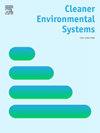印度土质与高密度聚乙烯衬里池塘养殖白对虾的生命周期评估
IF 4.9
Q2 ENGINEERING, ENVIRONMENTAL
引用次数: 0
摘要
白对虾(南美白对虾)养殖在世界范围内迅速扩大,对全球海产品供应作出了重大贡献。然而,对其环境影响的担忧仍然存在,特别是在印度——一个生产体系多样化的主要出口国。高密度聚乙烯(HDPE)衬砌池和土池被广泛使用,但它们的比较环境性能尚未得到全面评价。本研究旨在量化和比较沿印度西海岸高密度聚乙烯衬里和半密集的土塘对虾养殖系统对环境的影响。采用SimaPro软件和ReCiPe 2016 Midpoint方法进行了从摇篮到农场的生命周期评估(LCA)。主要数据收集自20个养殖场和一个孵化场,包括种子生产、饲料使用和能源消耗。环境影响通过多个类别进行评估,包括全球变暖潜势(GWP)、陆地酸化潜势(AC)和海洋富营养化潜势(EU)。结果表明,与土池相比,hdpe池每吨虾的GWP (369.04 kg CO2当量比268.06 kg CO2当量)和AC (1.20 kg SO2当量比0.94 kg SO2当量)显著高于土池,但EU (0.03 kg N当量比0.05 kg N当量)较低。种子生产、电力使用和饲料成为造成环境影响的主要因素。研究结果表明,从高密度聚乙烯衬里池塘系统过渡到土质池塘系统,采用太阳能通风等可再生能源,并用植物性替代品替代鱼粉,可以大大提高印度虾类水产养殖的可持续性。本文章由计算机程序翻译,如有差异,请以英文原文为准。
Life cycle assessment of whiteleg shrimp farming in earthen vs. HDPE-lined ponds in India
Whiteleg shrimp (Penaeus vannamei) farming has expanded rapidly worldwide, contributing significantly to global seafood supply. However, concerns remain about its environmental impacts, particularly in India—a major exporter with diverse production systems. High-Density Polyethylene (HDPE)-lined ponds and earthen ponds are widely used, but their comparative environmental performance has not been comprehensively evaluated. This study aimed to quantify and compare the environmental impacts of intensive HDPE-lined and semi-intensive earthen pond shrimp farming systems along India's west coast. A cradle-to-farm-gate Life Cycle Assessment (LCA) was conducted using SimaPro software and the ReCiPe 2016 Midpoint method. Primary data were collected from 20 farms and one hatchery, covering seed production, feed use, and energy consumption. Environmental impacts were assessed across multiple categories, including Global Warming Potential (GWP), Terrestrial Acidification Potential (AC), and Marine Eutrophication Potential (EU). Results showed that HDPE-lined ponds had significantly higher GWP (369.04 vs. 268.06 kg CO2 eq) and AC (1.20 vs. 0.94 kg SO2 eq) per tonne of shrimp compared to earthen ponds, but lower EU (0.03 vs. 0.05 kg N eq). Seed production, electricity use, and feed emerged as the primary contributors to environmental impacts. Findings suggest that transitioning from HDPE-lined to earthen pond systems, adopting renewable energy sources such as solar aeration, and replacing fishmeal with plant-based alternatives could substantially improve the sustainability of Indian shrimp aquaculture.
求助全文
通过发布文献求助,成功后即可免费获取论文全文。
去求助
来源期刊

Cleaner Environmental Systems
Environmental Science-Environmental Science (miscellaneous)
CiteScore
7.80
自引率
0.00%
发文量
32
审稿时长
52 days
 求助内容:
求助内容: 应助结果提醒方式:
应助结果提醒方式:


